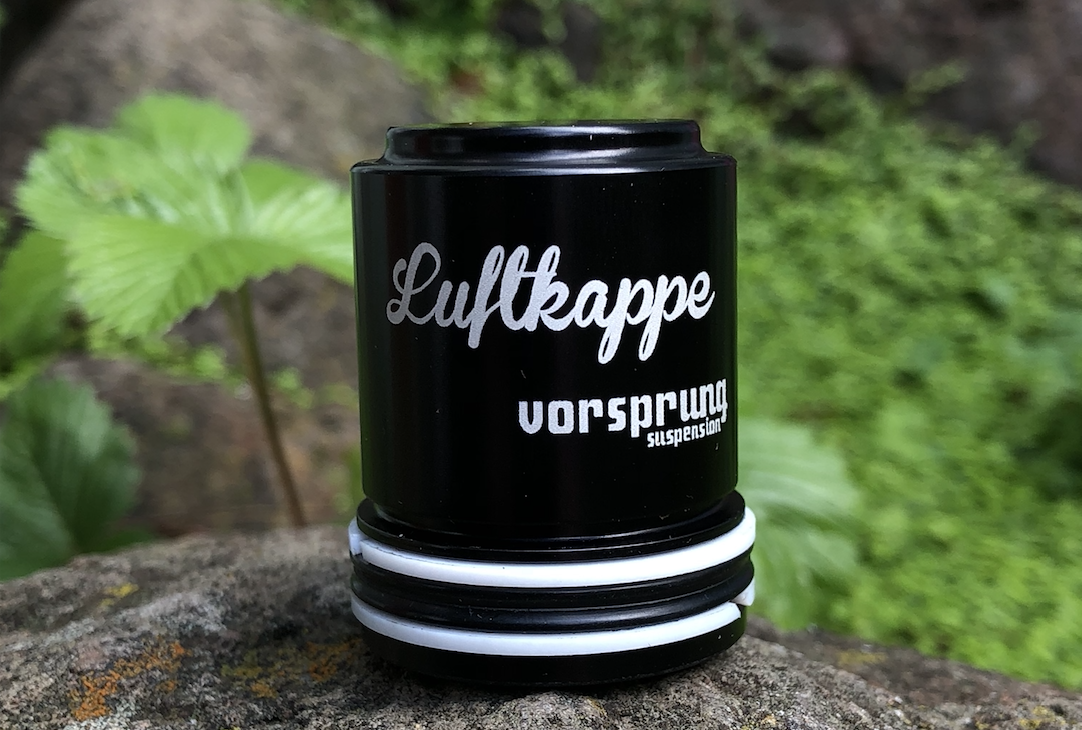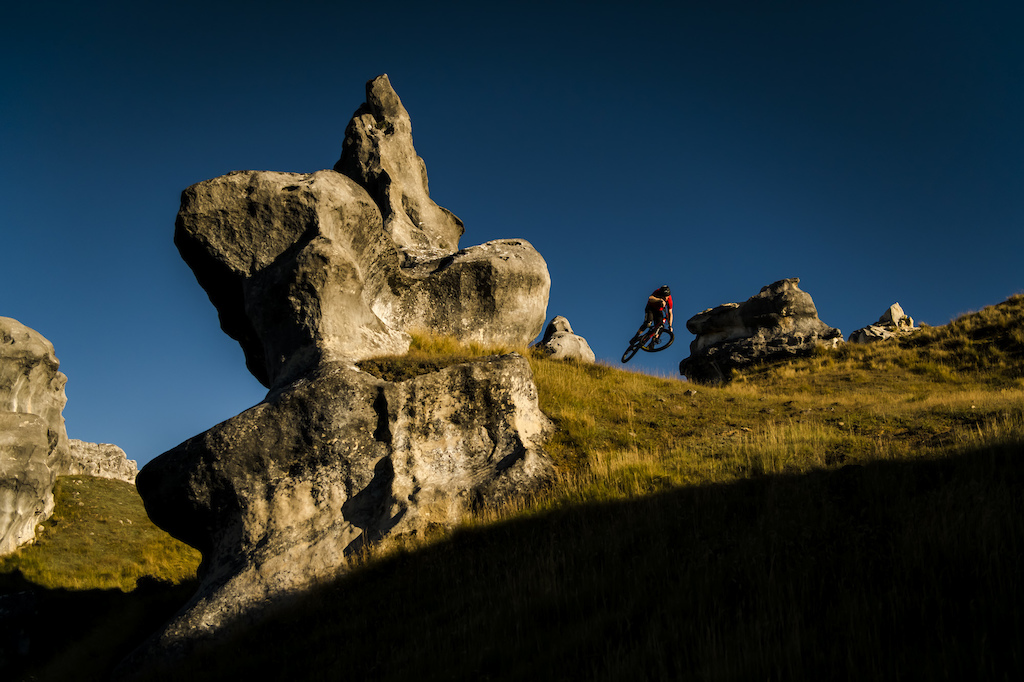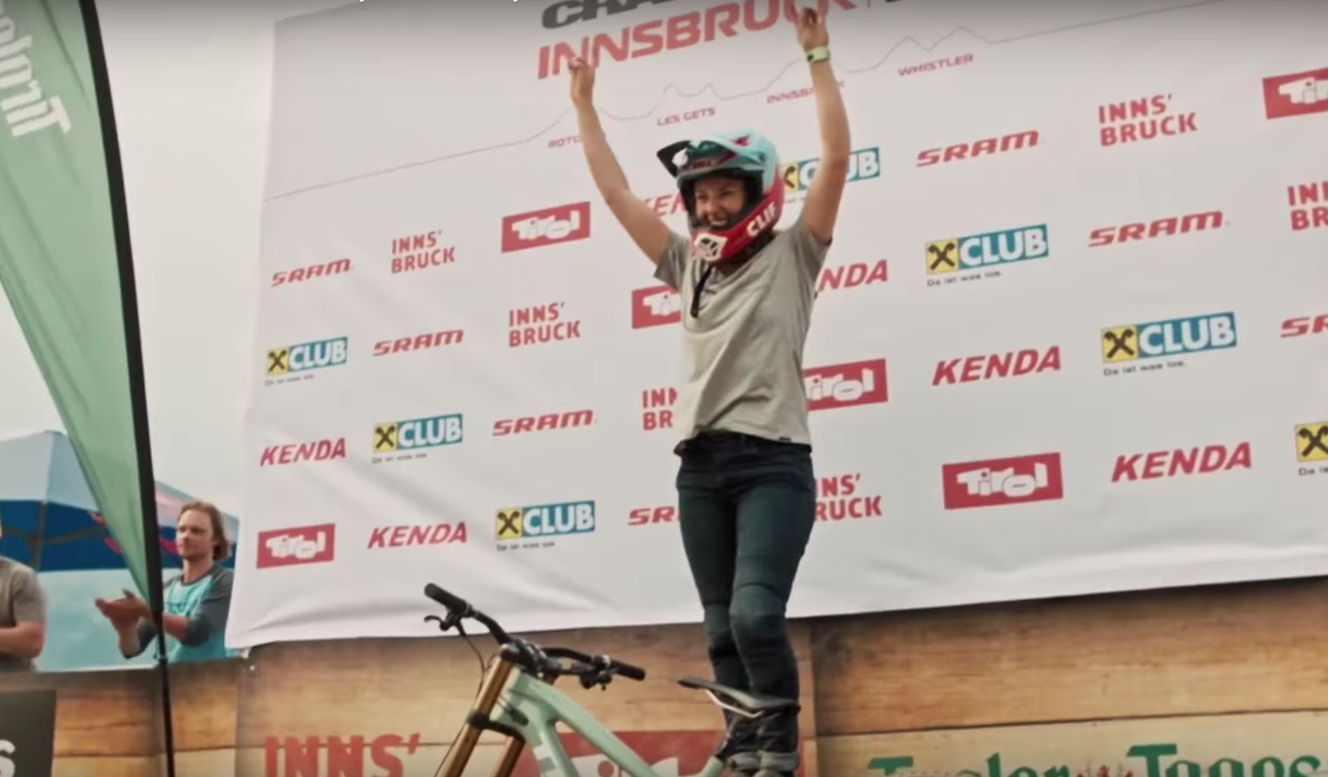Vorsprung Suspension is a Whistler, BC based company whose specialty is…well, suspension, just as you’d expect. Aside from offering servicing, they make and sell upgrade kits for damping and air spring tuning. I first heard about them when they received high praise for their Corset sleeves for FOX rear shocks a few years ago. More recently, they introduced the Luftkappe – a simple cap (that happens to be very nicely machined) which replaces the piston on the end of a fork’s air spring shaft and increases the negative air spring volume. Currently there are Luftkappes for RockShox Pike, Lyrik and Yari SoloAir/Debonair as well as FOX 34 and 36 Float forks. **The Luftkappe does NOT work with travel adjust models of the aforementioned forks. For the last couple of months I’ve been blasting around on a 2017 RockShox Lyrik SoloAir RCT3 with the Luftkappe installed. Read on to see how it’s been working out…

Details
- Larger negative air chamber
- Lower initial spring rate
- Reduces required compression damping
- Retains Bottomless Token compatibility
- Optional 10mm shaft clamps available for self-install
- Luftkappe A1 kit only: $85 CAD ($68USD approx)
- 10mm shaft clamps: add $28 CAD ($23USD approx)
If you’ve had experience with a variety of modern RockShox forks, you’ll notice that there isn’t a fixed formula to the air spring setup – it varies between models. For instance, at 185 pounds, to get the right amount of progression on a 29″ Pike with 120mm of travel, I’ve used 4-5 volume reducers; with a 27.5″ Lyrik with 170mm of travel, I’ve used just one volume reducer. Basically, there is no single, correct answer for the number of volume reducers required for a given rider at a certain weight that applies across the entire line of forks. This is due to the fact that as forks’ dimensions change, the positive : negative air spring ratio usually varies. Because of this, the Luftkappe isn’t necessarily ideal on all forks, for all riders. Performance gains will also vary with travel and rider weight, so if you’re considering the upgrade, have a browse around Vorsprung’s website or shoot them a quick email. They are very up front and honest about what you can expect from the Luftkappe with regard to your particular situation.
Installation
Installing the Luftkappe is rather simple actually; if you’re up to task with a basic fork service, you can surely pop it in yourself. You can however send your fork in and have it installed by Vorsprung if you’d like. Starting with this video as a frame of reference, remove the lower leg assembly. You can also refer to Vorsprung’s installation page for a very thorough breakdown of the procedure. Before you start, make sure you take note of your fork pressure. You’ll almost certainly be using a bit more pressure after the Luftkappe is installed. Anyhow, once you’re in, you’ll need to remove the air spring assembly…

Using a pair of circlip pliers, unseat the retaining ring that secures the air spring assembly, then gently pull it out.

Using a pair of 10mm shaft clamps, carefully clamp the air spring shaft in a vice as shown. Then, with a 4mm allen key, loosen and remove the stock piston. Make sure you clean the shaft with Isopropyl alcohol so it doesn’t slip in the clamps.

Your Luftkappe will arrive looking as if it’s a one piece unit. Unthread it by hand to separate the two pieces.

We’ll be re-using the bolt that secures the piston, but swapping out the o-ring at the base of the bolt with a supplied, fresh o-ring. Add a drop of red loctite to the threads and reassemble with the base of the Luftkappe.

Tighten the piston bolt to 50-55in.lbs (5.6-6.2 Nm)

Paying close attention to orientation of the above parts, we’ll be removing the top out bumper and no longer using it.

This is what your air spring shaft will look like after the install. Coat the pistons thoroughly with slick honey and re-install it into your fork’s upper leg assembly paying very close attention and making sure that the lockring snaps in place securely. After that, follow the procedures to re-assemble your fork.
Setup
Purely for a frame of reference, at ~185 pounds, I was running between 79-81 PSI in my 170mm travel Lyrik with 1 volume reducers. These numbers provided me with around 20% sag and I rarely got full travel. Once I installed the Luftkappe, I eventually found my sweet spot with about 87 PSI and NO volume reducers. This put me closer to the 25-30% mark with sag and provided a much different ride. While every setup will vary with personal preference, you can expect to run more pressure, less volume reducers and a higher rate of sag.
Since you remove the physical top out bumper, your fork will have a pneumatic top out and it will sit just a few millimeters deeper into the travel in its static, unweighted position. My 170mm fork’s travel came down to around 166mm. You may want to consider playing around with a spacer under your stem to compensate for slight variances in ride height.
On the trail
The change in behavior will be immediately obvious to anyone who’s discerning about their suspension. Right away I noticed was how light the fork’s initial action became. Small bumps and chatter just completely vanished underneath me compared to the stock setup. With that in mind, if you like your fork to feel fairly firm off the top and linear throughout the stroke, then this kit is definitely not for you. Before even getting it on the trail, I could tell that it became extremely progressive, even without a single volume reducer. This whole experience has been a bit of a strange, but good dichotomy. It’s difficult to wrap my head around the fact that my sag increased 5-10% as I sit a bit deeper in the travel, yet somehow my fork still feels supportive and doesn’t wallow. As of the time of writing this, I still have not been able to get full travel and bottom my fork out. Even on big hits, I have about 3-5mm of travel left. With that in mind, the support on big hits is phenomenal.

The Luftkappe helped my Lyrik manage successive, mid-sized hits more effectively. Striking a balance between compliance and support in the mid-stroke is no easy task. On baby heads, big roots and braking bumps, the ride was vastly different and I couldn’t quite put a finger on it at first, but I think it may come down to the pneumatic top out. Having a supple top out with more negative travel really helped in rough sections of trail where my fork transitioned between smashing an obstacle then being off the ground momentarily. That transition was more seamless and the front end remained more calm and composed in hectic situations. Basically, directional changes were better managed and my fork really just gobbled everything up and left me less rattled. I expected to have a bit less pop up front, due to the increased sag, but I was completely wrong in making that assumption. Despite sitting a bit deeper in the travel, my front end somehow became even more lively. As mentioned before, I did throw an additional 2.5mm spacer under the stem to get the ride height back up just a touch.
Overall
To be quite honest, the best way to sum up the ride is in Vorpsrung’s words: “Coil-like feel without the harsh bottoming of a completely linear spring”. The neurotic side of me keeps wants to think that because I’ve lost a few millimeters of travel on each end and since I’m running way more sag than I usually do, something must be wrong. I’ll admit that it’s all in my damn head and that the performance gains are definitely there. In stock form, my Lyrik was already a really good fork, but I do think it is noticeably better with the Luftkappe. If you’re the type of rider who likes to fiddle with suspension, you’ll probably have fun dabbling with this kit, provided you aren’t too hung up on getting exactly the full XXX millimeters of travel out of your fork. Last, but not least – if you’re on the fence, don’t hesitate to reach out to Vorsprung and ask if a Luftkappe makes sense for you, your fork and your expectations.







